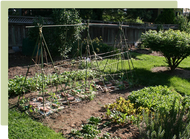Posted by by the Gubba Team
9th Aug 2023
August Garden Guide

August: the last "official" month of winter! Spring is on the horizon. While there's still a decent amount of cold & wet weather ahead, we can start thinking about the busy growth seasons coming up. Read on for what to plant in August, some general maintenance tasks, and a reminder on refreshing your soil before spring.
WHAT TO PLANT THIS MONTH

Plant strawberries if you haven’t done so already - get them in now so they get the benefits of the cold weather. For your established strawberry plants, remember to pinch out the first few flowers to let the plant become more established. This will set you up for a better harvest.
Plant rhubarb, and lift and divide any established crops.
Start sprouting your seed potatoes; get these in by September at the latest if you want to harvest by Christmas.
The following seeds can be sown now: kale, culiflower, cabbage, celery, beetroot, lettuce, broccoli, silverbeet, peas, carrots and spinach.
These seedlings can be planted: spinach, cabbage, broccoli, cauliflower, lettuce, leeks, and silverbeet.
IN THE FLOWER GARDEN
Plant summer flowering bulbs: dahlia (in frost protected areas), begonias, and gladioli. Add some bulb food to the soil as you plant them. Add a top dressing of bulb food to your spring flowering bulbs while you’re at it.
New season roses are in store and can be planted!
You can also plant hebes, violas, azaleas, lavender, rhododendrons, calendula.
Hopefully you’ll be enjoying the first of your spring flowering bulbs; hyacinth, daffodils and tulips, depending on your location.

OTHER TASKS TO DO IN AUGUST...
Protect your winter crops from fungal and bacterial diseases with some FreeFlo Copper. Continue to spray approx. once every 2 weeks.
Use Enspray Oil to control sooty mold, mites, aphids and white fly on fruit and citrus trees. The oil smoothers pests & their eggs to protect your plants. A low toxic option for controlling pests.
Give your established blueberries & strawberries a head start with some fruits & berries food.
Now is a good time to fertilise the lawn, ready for spring growth over the next few months.
Dig in your established cover crops. They’ll break down into the top layer of soil within a few weeks, adding valuable nutrients back into the soil.
Plan your crops for the upcoming season! Spring is on the horizon, so now’s the time to sit down (we recommend with a nice cup of tea) and plan out what you want to grow, and where to plant it. This Five Year Record Book from the RHS is great for planning & recording.
REFRESHING YOUR SOIL FOR SPRING
In order to get the most out of our gardens, whether that’s more flowers, bigger veggies, or increased resistance to pests and diseases - we need to feed and enrich our soil. The simplest and most effective way is to add organic matter. This can improve soil structure, nutrient content, and water-holding capacity, leading to more abundant growth.
Prepare your garden for spring planting by digging in generous helpings of organic matter like compost, worm castings, sheep pellets, manure, leaf litter or lime. Dig your organic matter about 5cm into the top layer of soil to enrich it for the upcoming growth season.


























